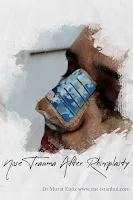What Happens If You Get a Impact on Your Nose After Rhinoplasty?
After the rhinoplasty operation, the nose may be traumatized, albeit unintentionally. Generally, simple accidents, hand or arm impact, a child throwing his head back while approaching, or a distant object may hit your nose. It may be unbelievable, but in many patients who say "I protect my nose", it can develop by chance and suddenly. Interestingly, the risk of nasal trauma may be reduced in patients with long-term nasal tape because it may mean that the nose tape that stands out at any time and the operation is emphasized.
After a rhinoplasty operation, when there is nasal trauma, the probability of trauma-related nasal damage increases in the following cases:
- Very strong traumas to the tip of the nose or to the nose from the side. In these traumas, the protective effect of the external cast on the nose will be less. If this trauma has occurred after the first week has been completed and the external splint has been removed, all traumas that come from all directions are risky.
- The earlier the nose trauma occurs after the rhinoplasty operation, the greater the negative impact may be. The suture materials that fix the cartilage under the nose skin are very thin and not resistant to strong traumas. For example, if the patient stands up immediately after the operation, a drop in blood pressure or a feeling of faintness may occur. For this reason, very serious nasal traumas may occur in patients who are stunned or fall. When there is nasal trauma in the early period, because the nose is already edematous, trauma-related injuries may not be evaluated as flesh during the examination. After weeks, the effect of trauma to the nose can be understood.
- Trauma-related nasal deformity is more likely to occur in patients with broken nasal bones or undergoing complicated operations. Nasal deformity due to trauma is more likely to occur in patients whose nasal bone is cut or broken on a planned basis than in patients whose nasal bone is not ruptured.
After the rhinoplasty operation, the healing of cartilage and soft tissues is 80% complete in 2 months. In this process, patients should be as careful as possible to avoid nasal trauma. Sometimes, even if an uninformed dentist removes the lip asymmetrically, it may cause trauma to the tip of the nose.
Sometimes, patients need to be more careful because of their professions that are at risk of nasal trauma. For example, protective plastic-style face apparatus can be used for patients with sports and face-to-face activities.
What Happens If Nose Trauma Occurs After Rhinoplasty Operation?
First of all, if there is a nasal trauma in the first week after the operation, you should inform your doctor about this situation. Although the silicone splints in the nose and the external nasal cast protect the nose against trauma to a limited extent; Depending on the severity of the trauma and the surgery performed, tissue changes in the nose may occur in amounts.
If the nasal trauma occurred in the second week or later after the rhinoplasty operation, you should inform your doctor about whether there is no shape change in the nose after the trauma, whether there is edema or bleeding in the nose. During this period, changes in bone tissue or cartilage due to trauma due to edema on the nose may not be detected during examination. Traumatic problems can be understood during the examination of the patients weeks or months later. After classical complicated rhinoplasty operations performed with bone incision, slippage of nasal bone lamellae, displacement or shape changes in cartilage grafts may occur after nasal trauma. Occasionally, septal hematoma and displaced nasal fractures may also be seen. In the first weeks after the rhinoplasty operation, the camouflage effect due to nasal edema causes the examination findings to become indistinct.
What to Do When Nose Trauma After Rhinoplasty Operation?
When there is nasal trauma after rhinoplasty operation, you can pay attention to the following recommendations:
- If you think that there is a change in the shape of the nose, you can contact the doctor who performed the surgery. Sometimes, patients can hear "tearing sound, cartilage breaking sound, bone sound" in the nose during trauma.
- In order to reduce nasal swelling, attention can be paid to the leaders such as standing in a cold environment and close to the vertical as if a new nose operation has been performed, applying ice, applying local cold arnica gel to relieve edema, drinking bromelain tablets.
- If nosebleeds have started, it may be useful to draw cold water into the nose, apart from applying cold to the outside of the nose. There are various nasal sprays and drugs that can stop bleeding, but it is appropriate to inform the surgeon who operated on you in case of continuation of nose bleeding.
Murat Enoz, MD, Otorhinolaryngology, Head and Neck Surgeon
Private Office:
Address: İncirli Cad. No:41, Kat:4 (Dilek Patisserie Building), Postal code: 34147, Bakırköy - İstanbul
Appointment Phone: +90 212 561 00 52
Appointment Phone: +90 212 561 00 52
Fax: +90 212 542 74 47


Comments
Post a Comment